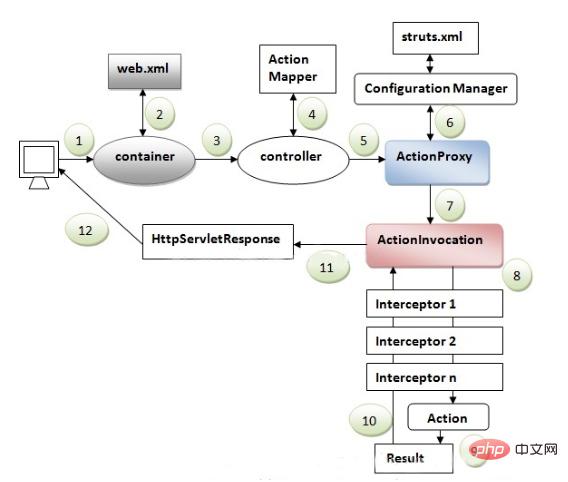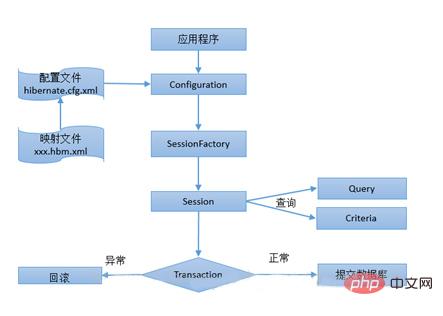What is the principle and process of ssh framework

Struts2 working principle:
1. Initialize a request pointing to the servlet container.
2. The request is filtered by the filter configured in web.xml, and the FilterDispatcher (the core of the struts2 controller) asks the ActionMapper whether it needs to call an Action to handle the request. If ActionMapper decides that an Action needs to be called, FilterDispatcher hands over request processing to ActionProxy.
3.ActionProxy finds the Action class that needs to be called through the configuration file Struts.xml configuration file.
4.ActionProxy creates an ActionInvocation instance, and ActionInvocation calls Action through proxy mode. But before calling, ActionInvocation will load all Action-related Interceptors (interceptors) according to the configuration.
5. After the Action is executed, ActionInvocation is responsible for finding the corresponding return result based on the configuration in struts.xml.
Related recommendations: "FAQ"
That is, the developer sends an http request. This request is filtered through the web.xml filter to see if a certain action, if there is one, find the method implemented by the request in Struts.xml, and then return the running result. As shown in the figure:

Hibernate working principle:
1. Read and parse the configuration file
2. Read and parse mapping information, create SessionFactory
3. Open Session
4. Create transaction Transation
5. Persistence operation
6. Submit Transaction
7. Close Session
8. Close SesstionFactory
That is, when Hibernate managed by spring is initialized, xxx.hbm.xml is loaded and then the parsing mapping information is read and created. SessionFactory.
Then open the session, operate the thing through the session and submit it. Finally close the session and close the SessionFactory. As shown in the figure:

The three states of beans in Hibernate
Hibernate objects are divided into three states: transient state (new out) or independent of session when instantiated), persistent state (associated with session) and free state (used to be associated with session). Among them, the persistent objects are PO, and the transient and managed objects can be used as VO. (PO should not be used directly as the v layer) Therefore, attention should be paid to the transformation of the three states during use.
For example:
In a series of data operations, the save or saveorupdate operation can convert transient or free objects into persistent objects, while
delete or Operations such as close and flush of session will convert the persistent state object associated with the session into a free state.
The state and life cycle of Hibernate objects
The object initialized using the new operator is a transient (Transient) (does not have any behavior associated with the database table) , as long as the application no longer refers to these objects, their status will be lost and recycled by the garbage collection mechanism);
After the transient object passes save(), saveOrUpdate will be converted into a persistent state, which is managed uniformly by the session. The operation of persistent objects is synchronized with the database;
The persistent objects will be converted into free states after evict(), close(), clear(), etc. At this time, although they are persisted, they are not in the session cache. lock(),
update(), saveOrUpdate will be converted into persistent state. Objects obtained through get(), load(), find(), and iterate() are directly persistent.
How Spring works:
In the SSH framework, spring plays the role of managing the container. We all know that Hibernate is used as the persistence layer because it encapsulates JDBC well.
Programmers do not need to write a large number of SQL statements when interacting with the database. Struts is used as the application layer, which is responsible for calling the business logic serivce layer.
So the process of the SSH framework is roughly: Jsp page----Struts------Service (business logic processing class)---Hibernate (left to right)
struts Responsible for controlling the Service (business logic processing class), thereby controlling the life cycle of the Service. In this way, the dependence between layers is very strong and is coupled.
At this time, using the spring framework plays the role of controlling the Action object (in Strus) and the Service class. The relationship between the two is loose. Spring's Ioc mechanism (inversion of control and dependency injection ) is used here. Spring's Ioc (Inversion of Control and Dependency Injection):
Inversion of Control: The container controls the (dependency) relationship between programs, instead of being directly controlled by program code in traditional implementations.
Dependency injection: The dependencies between components are determined by the container during runtime, and the container dynamically injects certain dependencies into the components.
The second benefit of using Spring (AOP application):
Transaction processing:
In the past JDBCTemplate, the transaction was submitted successfully and exception The processing is done through Try/Catch in Spring.
Spring container integrates TransactionTemplate, which encapsulates all transaction processing functions, including transaction rollback when exceptions occur, data submission when operations succeed, and other complex business functions. This is all managed by the Spring container, which greatly reduces the amount of code for programmers and provides good management and control over transactions.
Hibernate also has transaction management. Transaction management in hibernate is accomplished by creating and maintaining Session through SessionFactory. Spring has also integrated the SessionFactory configuration, and there is no need to set the SessionaFactory through hibernate.cfg.xml.
In this way, you can make good use of Sping's powerful transaction management functions.
Avoids the need to obtain a Session instance to start transactions/submit/rollback transactions and cumbersome Try/Catch operations every time you operate on data.
These are good applications of the AOP (aspect-oriented programming) mechanism in Spring. On the one hand, it makes the development of business logic clearer and professional division of labor easier.
On the other hand, the application of Spirng AOP isolation reduces the coupling of the program, allowing us to combine various aspects in different applications, which greatly improves code reuse.
The above is the detailed content of What is the principle and process of ssh framework. For more information, please follow other related articles on the PHP Chinese website!

Hot AI Tools

Undresser.AI Undress
AI-powered app for creating realistic nude photos

AI Clothes Remover
Online AI tool for removing clothes from photos.

Undress AI Tool
Undress images for free

Clothoff.io
AI clothes remover

AI Hentai Generator
Generate AI Hentai for free.

Hot Article

Hot Tools

Notepad++7.3.1
Easy-to-use and free code editor

SublimeText3 Chinese version
Chinese version, very easy to use

Zend Studio 13.0.1
Powerful PHP integrated development environment

Dreamweaver CS6
Visual web development tools

SublimeText3 Mac version
God-level code editing software (SublimeText3)

Hot Topics
 1379
1379
 52
52
 How to evaluate the cost-effectiveness of commercial support for Java frameworks
Jun 05, 2024 pm 05:25 PM
How to evaluate the cost-effectiveness of commercial support for Java frameworks
Jun 05, 2024 pm 05:25 PM
Evaluating the cost/performance of commercial support for a Java framework involves the following steps: Determine the required level of assurance and service level agreement (SLA) guarantees. The experience and expertise of the research support team. Consider additional services such as upgrades, troubleshooting, and performance optimization. Weigh business support costs against risk mitigation and increased efficiency.
 How does the learning curve of PHP frameworks compare to other language frameworks?
Jun 06, 2024 pm 12:41 PM
How does the learning curve of PHP frameworks compare to other language frameworks?
Jun 06, 2024 pm 12:41 PM
The learning curve of a PHP framework depends on language proficiency, framework complexity, documentation quality, and community support. The learning curve of PHP frameworks is higher when compared to Python frameworks and lower when compared to Ruby frameworks. Compared to Java frameworks, PHP frameworks have a moderate learning curve but a shorter time to get started.
 How do the lightweight options of PHP frameworks affect application performance?
Jun 06, 2024 am 10:53 AM
How do the lightweight options of PHP frameworks affect application performance?
Jun 06, 2024 am 10:53 AM
The lightweight PHP framework improves application performance through small size and low resource consumption. Its features include: small size, fast startup, low memory usage, improved response speed and throughput, and reduced resource consumption. Practical case: SlimFramework creates REST API, only 500KB, high responsiveness and high throughput
 Astar staking principle, income dismantling, airdrop projects and strategies & operation nanny-level strategy
Jun 25, 2024 pm 07:09 PM
Astar staking principle, income dismantling, airdrop projects and strategies & operation nanny-level strategy
Jun 25, 2024 pm 07:09 PM
Table of Contents Astar Dapp Staking Principle Staking Revenue Dismantling of Potential Airdrop Projects: AlgemNeurolancheHealthreeAstar Degens DAOVeryLongSwap Staking Strategy & Operation "AstarDapp Staking" has been upgraded to the V3 version at the beginning of this year, and many adjustments have been made to the staking revenue rules. At present, the first staking cycle has ended, and the "voting" sub-cycle of the second staking cycle has just begun. To obtain the "extra reward" benefits, you need to grasp this critical stage (expected to last until June 26, with less than 5 days remaining). I will break down the Astar staking income in detail,
 Performance comparison of Java frameworks
Jun 04, 2024 pm 03:56 PM
Performance comparison of Java frameworks
Jun 04, 2024 pm 03:56 PM
According to benchmarks, for small, high-performance applications, Quarkus (fast startup, low memory) or Micronaut (TechEmpower excellent) are ideal choices. SpringBoot is suitable for large, full-stack applications, but has slightly slower startup times and memory usage.
 Golang framework documentation best practices
Jun 04, 2024 pm 05:00 PM
Golang framework documentation best practices
Jun 04, 2024 pm 05:00 PM
Writing clear and comprehensive documentation is crucial for the Golang framework. Best practices include following an established documentation style, such as Google's Go Coding Style Guide. Use a clear organizational structure, including headings, subheadings, and lists, and provide navigation. Provides comprehensive and accurate information, including getting started guides, API references, and concepts. Use code examples to illustrate concepts and usage. Keep documentation updated, track changes and document new features. Provide support and community resources such as GitHub issues and forums. Create practical examples, such as API documentation.
 How to choose the best golang framework for different application scenarios
Jun 05, 2024 pm 04:05 PM
How to choose the best golang framework for different application scenarios
Jun 05, 2024 pm 04:05 PM
Choose the best Go framework based on application scenarios: consider application type, language features, performance requirements, and ecosystem. Common Go frameworks: Gin (Web application), Echo (Web service), Fiber (high throughput), gorm (ORM), fasthttp (speed). Practical case: building REST API (Fiber) and interacting with the database (gorm). Choose a framework: choose fasthttp for key performance, Gin/Echo for flexible web applications, and gorm for database interaction.
 Detailed practical explanation of golang framework development: Questions and Answers
Jun 06, 2024 am 10:57 AM
Detailed practical explanation of golang framework development: Questions and Answers
Jun 06, 2024 am 10:57 AM
In Go framework development, common challenges and their solutions are: Error handling: Use the errors package for management, and use middleware to centrally handle errors. Authentication and authorization: Integrate third-party libraries and create custom middleware to check credentials. Concurrency processing: Use goroutines, mutexes, and channels to control resource access. Unit testing: Use gotest packages, mocks, and stubs for isolation, and code coverage tools to ensure sufficiency. Deployment and monitoring: Use Docker containers to package deployments, set up data backups, and track performance and errors with logging and monitoring tools.



